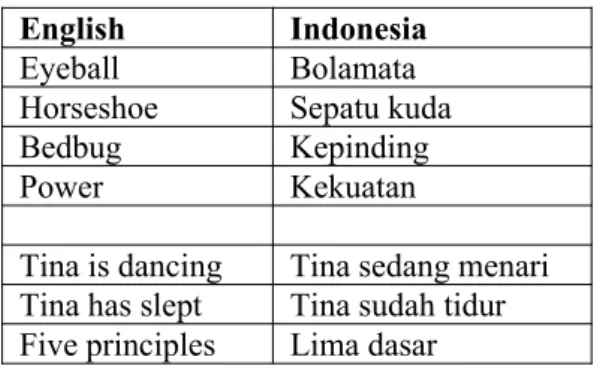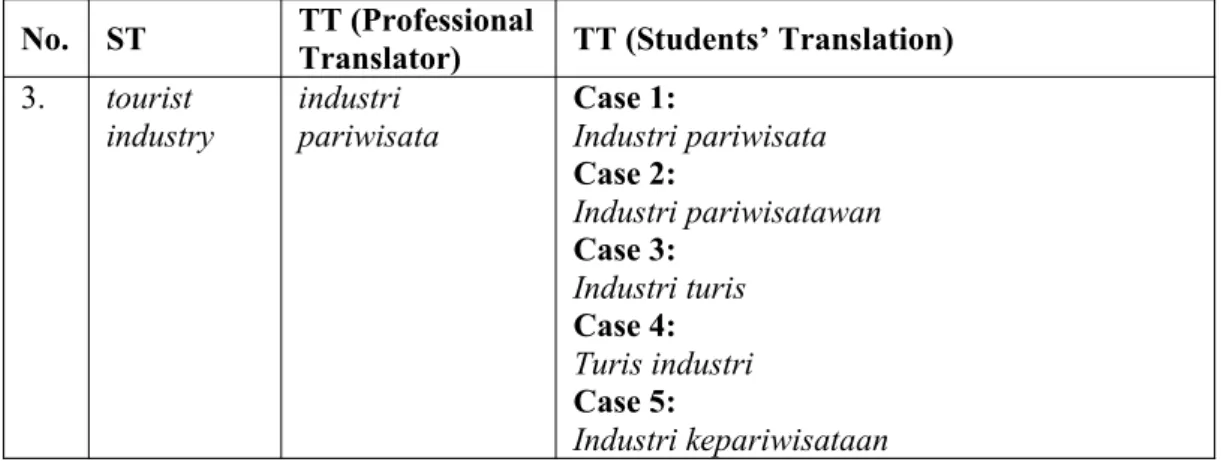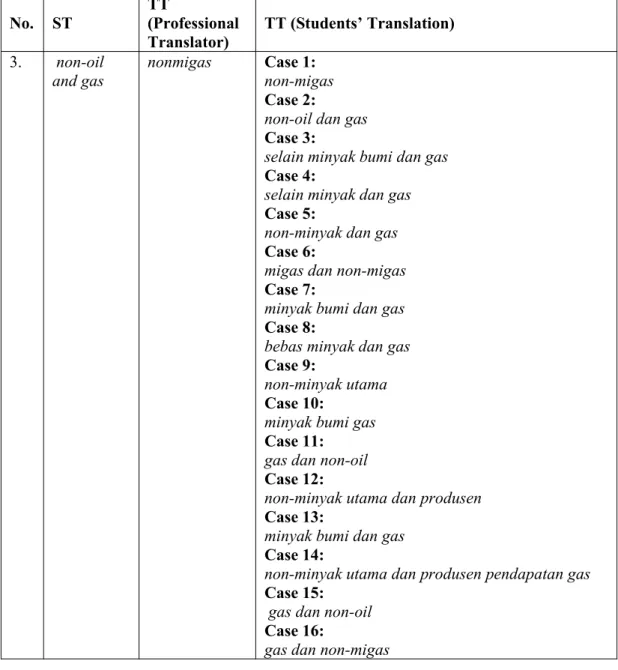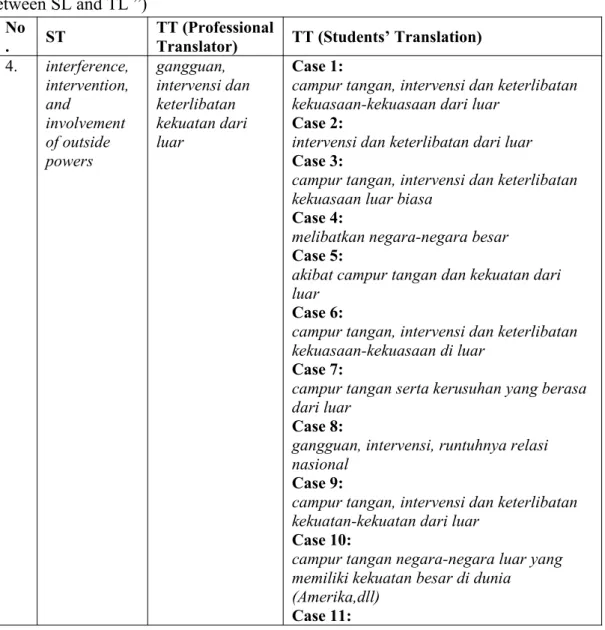English to Indonesian text translation in deep structure technical equipment in the Fifth Semester of the English Education Study Program at the State Islamic College of Jurai Siwo Metro (STAIN) in the academic year 2013/2014. How is translating students' english into indonesian text of deep structure technical equipment in fifth semester english students.
INTRODUCTION
Background of the Study
The researcher believes that when people have already mastered the meaning of the sentence, in this case definitely correlates with the deep structure technical devices, they will certainly easily know the purpose of the English sentence, so they will not find the difficulty. to understand the message of the foreign language. After the pre-survey was conducted on January 23, 2013, the researcher called the result data of mid-term score of the students from A class among 47 students as well as arranged an unstructured/closed interview to collect the data among ten students of the English Department on the fifth semester of State Islamic College (STAIN) of Jurai Siwo Metro.
Focus of the Research
- Problem Limitation
- Problem Formulation
Levitt, "The Relative Accessibility of Semantic and Deep-structure Syntactic Concepts", Memory & Cognition, vol. Referring to the result of the students' translation, the phrase "Campfire girls" was transferred to the correct translation (see case 2). Meanwhile, there have also been translation results that shorten the expression "The Camp Fire Girl" to "CFG".
Here, the expert translator changed the noun phrase "the national headquarters" to "kantor pusat nasional". According to the Oxford Advanced Learner Dictionary, the phrase "American Indian" can be translated as "Indian". Andrea “The relative accessibility of semantic and syntactic concepts of deep structure”, Memory & Cognition, 1978, vol.
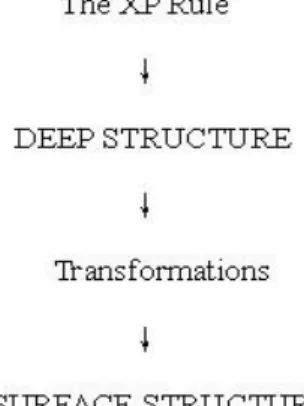
Objective of the Study
The Concept of Translation
- The Definition of Translation
- Translation within Across the History
This is because the main purpose of translation is to convey the content of the message in the mother tongue to the foreign language. In examining the translation tradition in the Indonesian archipelago, it cannot be separated from the local written tradition.
Kinds of Methods in Translation
- Word for Word Translation
- Literal Translation
- Faithful Translation
- Semantic Translation
- Adaptation
- Free Translation
- Idiomatic Translation
- Communicative Translation
This method usually puts words from the source language directly into the target language version. A faithful translation is an attempt to reproduce the correct contextual meaning of the original within the constraints of the target language's grammatical structures. Semantic translation is well-mannered than faithful translation, while faithful translation sounds clumsier and inflexible to the rule of the target language.
This is because the "form" (or rhetoric, for example plot or sentence form) of the target language was completely changed.
Translation Procedures
- Preparation
- Analysis
- Testing the translation
One of the steps in analysis is to be careful in studying these keywords, to get a good lexical equivalent in the foreign language. Special attention should be paid to the analysis of the opening and the closing of the text. Transfer is the process of going from the semantic structure analysis to the initial concept of the translation.
The work of analysis, transfer and initial drafting is not independent of the other.
Methods of Testing a Translation
- Comparison with the Source Language
- Back-translation
- Comprehensive
- Naturalness tests
- Readability tests
- Consistency checks
The purpose of this test is to see if the translation is understood or not by speakers of the language who have not seen the translation before. The purpose of this test is to observe whether the form of the translation is natural and the style appropriate. The process used by reviewers is to first read the entire translation piece at once.
There will also be times when the reader will actually say something other than what is in the translation.
A Brief History of Deep Structure
Some of these have to do with the technical details of presentation, and others have to do with the content of the transaction. For example, there must be consistency in the spelling of the names of people and places. The second is called surface structure or S-structure, which is formed by using suitable transformations for the deep structure of the sentence in question.
Moreover, transformation itself means the process of generating the deep structure in the more complicated surface structure of a sentence.18 Once a type of transformation has been applied to the lexical entry of the noun or verb into the deep structure, a particular constituent is introduced into the area of the NP and VP in the surface structure.
The Concept of Deep Structure
From the above theoretical descriptions, it can be concluded that the meaning of deep structure is to highlight the meaning of a sentence that usually occurs in or within the human brain. The deep structure is the place where the linguistic process actually took place or the mental and the surface structure is the concrete physical that has transformed from the deep structure. The two most important differences between deep and surface sentence structure analysis are (1) the order of the constituents in one relative to.
Briefly, the general form of the analysis resembles the surface structure analysis of the sentence, with additional indications of displaced constituents and where they are located in the deep structure.
The Devices in Deep Structure
- Translation
- Transliteration
- Transposition
- Literal
- Borrowing
- Modulation
- Adaptation
Meanwhile, according to Newmark (1988), there are four types of transposition:32 1) Type I : the change from singular to plural or in the position of. The strong reason for borrowing words is that people sometimes struggle to understand the messages in the translated form. Modulation is a variation of the form of the message, achieved by a change in the point of view.
In addition, this technique is related to the other definition developed culturally in the middle of the community.

The Assesement of Translation Study
The exact translation from the above table was cases 1 and 3. However, there were also results that were categorized as less accurate, which were cases 2 up to 10. 2. The accuracy level of deep structure phenomena. D.1: the percentage average of the exact level of all deep structure phenomena D.2: the percentage average of a less accurate level of all deep structure phenomena. the percentage of exact level of adaptation. A.2: the percentage of less accurate level of adaptation A.3: the percentage of inaccurate level of adaptation B.1: the percentage of accurate level of borrowing B.2: the percentage of less accurate level of borrowing B.3: the percentage of inaccurate level of Loan M.1: the percentage of accurate level of Modulation M.2: the percentage of less accurate level of Modulation M.3: the percentage of inaccurate level of Modulation T .1: the percentage of exact level on completion.
T.2 : the percentage of less accurate level of Transposition T.3 : the percentage of inaccurate level of Transposition Px.n* : the percentage of accurate level each phenomenon Py.n* : the percentage of less accurate level each phenomenon Pz. n* : the percentage imprecise level of each phenomenon n* : number of phenomena.

Types and Characteristics of the Study
Data Resources
The case study belongs to qualitative research, where all collected data is based on the description of the researcher in the test, interview and documentation. The data sources in this present research including student translation results acting as the primary source collected through the test and Deep Structure technical devices as the secondary source. It is done by taking the topic as the focus of the research, rather than strata, coincidence or region.
The subject that will be focused on in this research is the fifth students in the English Education Study Program at the State Islamic College (STAIN) Jurai Siwo Metro in the academic year 2013/2014.
Data Collection Technique
- Test
- Interview
- Documentation
It can be assumed that a test is one of the devices to measure the students'. In addition, the researcher uses test as one of the data collection methods to measure the students' translation result in the translation of English into Indonesian text in the term of Deep Structure technical devices. Esterberg (2002) states that an interview is "a meeting of two persons to exchange information and ideas through questions and answers, which leads to communication and joint construction of meaning on a particular subject".44 Therefore, the conclusion can be drawn becomes that maintenance is the prominent. source in case study.
In this case, the interview is used to obtain data about the students' difficulties in studying translation and is used as a secondary source.
Data Analysis technique
Approach
Documentation is the complementary instrument from the use of observation and interview method in qualitative research. In this research, the researcher uses a naturalistic approach where the data collected is the real state. The main research is the subject or fifth semester students of English education study at State Islamic College (STAIN) in Jurai Siwo Metro in the academic year 2013/2014.
A case study is research that essentially diagnoses the symptoms in the research subject and describes them in narrative form.
RESULT OF THE RESEARCH
Description of The Research Setting
- STAIN Jurai Siwo Metro
- English Education Study Program
General Description of Research Data
As the primary research, data was taken through the translation product of the students in semester 5, which was ordered by the lecturer as the main assignment of the class. Two numbers for Transposition, two numbers for Borrowing, two numbers for Modulation and two numbers for Adaptation. By analyzing the data, the researcher starts from the fact that the more variation answers the students give in each task number, the more analyzes are produced.
Therefore, the analysis does not depend only on the number of tasks, but also on the amount of variation answers given by the informants (students).
The Description of Data Analysis
- Deep Structure Phenomena
Moreover, if the translation result is observed from the students' translation, they prefer to add affix (kepariwisatawan) and to use unstandardized language (turis). Nevertheless, the rest of the translation result of the students shows that they translated the phrase. So the students' translation result above can be categorized as accurate level which was case 1 and 3, "bermalas-malasan" as less accurate translation.
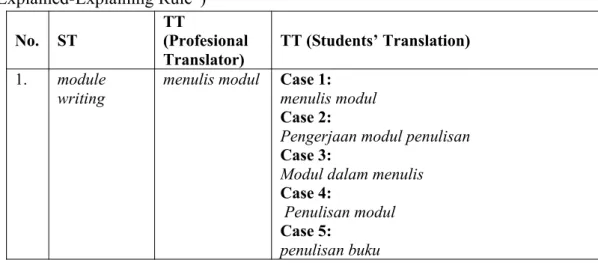
CONCLUSION AND SUGGESTION
Conclusion
Remember the numbers of accurate, less accurate and inaccurate level of the students' translation from English to Indonesian result, the dominant device that occurs mostly accurate level is Modulation and Adaptation, less accurate is Transposition and Borrowing. Therefore, the students' English translation into Indonesian text in the term of Deep Structure Technical Devices at the fifth semester students of English Education study program at STAIN Jurai Siwo Metro in the academic year of 2013/2014 was varied, but only adaptation and borrowing which often occurred errors then have the highest numbers of less accurate and inaccurate level within.
Suggestion
The accuracy Level analysis of phenomena (using navy blue and white with red accents).
